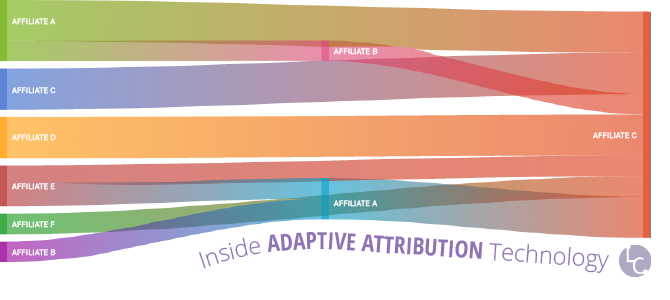Last month our Tech Tuesday discussion revolved around the highlights of LinkConnector’s unique Cross Platform Tracking (CPT) technology. If you missed it, you can check it out here. This month, I’d like to introduce Adaptive Attribution, which takes advantage of CPT and the underlying technology developed to support it. Adaptive Attribution is a term coined by my Co-Founder, Choots Humphries, to encompass the multitude of attribution options LinkConnector has available. You can read more about those options here. This post will outline some of the technologies that allow Adaptive Attribution to happen.
Before detailing the technologies, let me answer the burning question: Why do I care about Adaptive Attribution?
Well, for the most part, affiliate marketing attribution has historically occurred on a last click or first click basis. This structure limits a merchant to only two options, leaving the merchant no choice but to give the entire commission to only one affiliate even though many may have been involved in the transaction. You care about this as a merchant because you are fair-minded and want to reward your affiliates appropriately for their part in bringing you a customer. That fair-mindedness will result in a much stronger affiliate program and increased sales for the merchant. You care as an affiliate because you deserve some share of the commission for a promotion that turns into a sale.
So, what technologies help make Adaptive Attribution possible? I’ll touch on a few of the key elements: Server-Side Cookies, Clickstream and Shopping Cart Window (SCW).
Server-Side Cookies
LinkConnector was one of the first networks (we’ve been doing it now for over 11 years) to use server-side cookies as a method for tracking promotions. What this means is we don’t simply rely on client-side cookies which generally only track the last click a user made on an affiliate link. Instead we record cookie information on our servers for the duration of the promotion cookie’s life. This allows us to log a history of user activity regarding the promotion of the merchant’s offer, providing us with unique insight into the user’s clickstream.
Clickstream
Our analysis indicates that there are multiple affiliate cookies involved in any transaction 10-20% of the time. This means that as much as 20% of the time, merchants can divide the commission appropriately among the affiliates involved. While not all Adaptive Attribution methods rely on a multi-affiliate clickstream, most do, making this technology essential to attribution decisions. Of course, we don’t just have knowledge of which affiliates were involved in a clickstream, but we also see the time at which an affiliate was involved. This allows merchants to reward affiliates based upon how close to the final sale a promotion occurred. Other networks make assumptions about promotions that occur toward the end of a transaction (i.e., when a user entered the shopping cart), which leads me to the next key element of Adaptive Attribution— the Shopping Cart Window (SCW).
Shopping Cart Window
Basically the SCW is a technology we employ that identifies the precise time in which a user enters the shopping cart. Armed with this information, LinkConnector can help a merchant decide how to reward affiliates for promotion inside and outside the shopping cart. Some may choose to reward promotion that occurs inside the window at a lower commission rate, reserving the bulk of the commission for affiliate promotion outside the cart.
SCW technology is powerful as it doesn’t record a promotion as being inside the cart window that may have legitimately occurred outside the cart window based on an arbitrary period (say 1 hour). Thanks to SCW, LinkConnector knows precisely when a user entered the cart and how long they were there.
In addition to Server-Side Cookies, Clickstream and Shopping Cart Window, there are several other next-generation affiliate marketing technologies we have developed that assist in Adaptive Attribution—many of which will be covered in subsequent technology posts. You will begin to notice that our developers have purposefully designed our technologies to complement one another in a seamless and cohesive manner. So, until next time…

